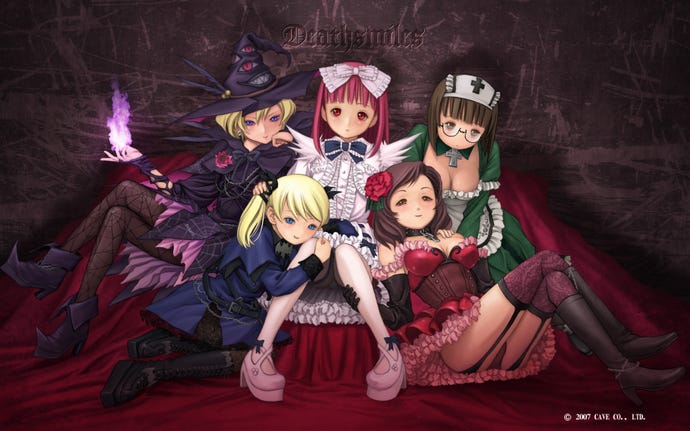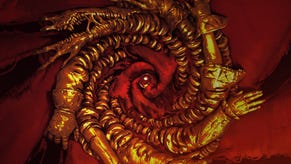Ten Great Bullet Hell Shooters
Are you ready to challenge the barrage? Here's ten of the best danmaku shmups on all platforms.
This article first appeared on USgamer, a partner publication of VG247. Some content, such as this article, has been migrated to VG247 for posterity after USgamer's closure - but it has not been edited or further vetted by the VG247 team.
The danmaku (or "bullet hell") subdivision of the shmup genre includes some of the most challenging games you'll ever play. Designed with the same focus on finesse and skill that a good fighting game challenges, danmaku shmups will test your gaming abilities to the absolute limit.
Up until relatively recently, danmaku titles were a largely Japanese affair, with relatively few examples making it to Western territories. This has changed significantly in recent years, however, with many of Cave's titles making the journey West, many other Japanese titles being released in region-free format and a variety of Japanese and Japanese-inspired developers releasing titles for mobile phones and Windows PCs.
Here's ten of my personal favorites, in no particular order, but these are far from the only ones on the market. Doubtless you all have your own favorites, dear readers, so, as ever, feel free to disagree with my choices and share your own favorites in the comments!
Espgaluda II

Cave's Espgaluda II originally hit Japanese arcades in 2005, was subsequently ported to the i-mode mobile service in 2006 then brought to the Xbox 360 in an enhanced "Black Label" form in 2010. Shortly after the Xbox 360 release, Cave brought Espgaluda II to iOS and Android, bringing with it an all-new smartphone-specific mode which changed up the game mechanics to be more friendly to touchscreen play. Espgaluda II also has a separate "HD" iPad version available on the App Store.
The original arcade version of Espgaluda II, which is also playable in the mobile versions, sees players destroying enemies with one of three different characters, each of whom has their own attack patterns. By collecting colored gems, you can trigger a special mode called "Awakening," during which time enemies and bullets slow down. While Awakening is active, any enemies destroyed have all their on-screen bullets turned into gold, but at the same time release additional bullets when defeated. These new bullets can be destroyed by defeating another enemy, allowing for the creation of long chains for high scores.
The smartphone mode, meanwhile, uses largely similar mechanics, but when triggering Awakening the player character is fixed in place. In this case, tapping on the screen triggers an explosion at the location tapped, which cancels bullets and turns them into gems (allowing Awakening to continue for longer) as well as destroying enemies. The longer the player remains in Awakening mode, the higher the multiplier climbs, and when the player exits Awakening mode, all on-screen bullets are turned into gold. The more gold a player has, the faster their score climbs, but the gold stock gradually counts down while fighting bosses.
Why you should play it: Interesting mechanics, excellent music and some impressive 2D graphics make this one of Cave's finest.
DoDonPachi Resurrection
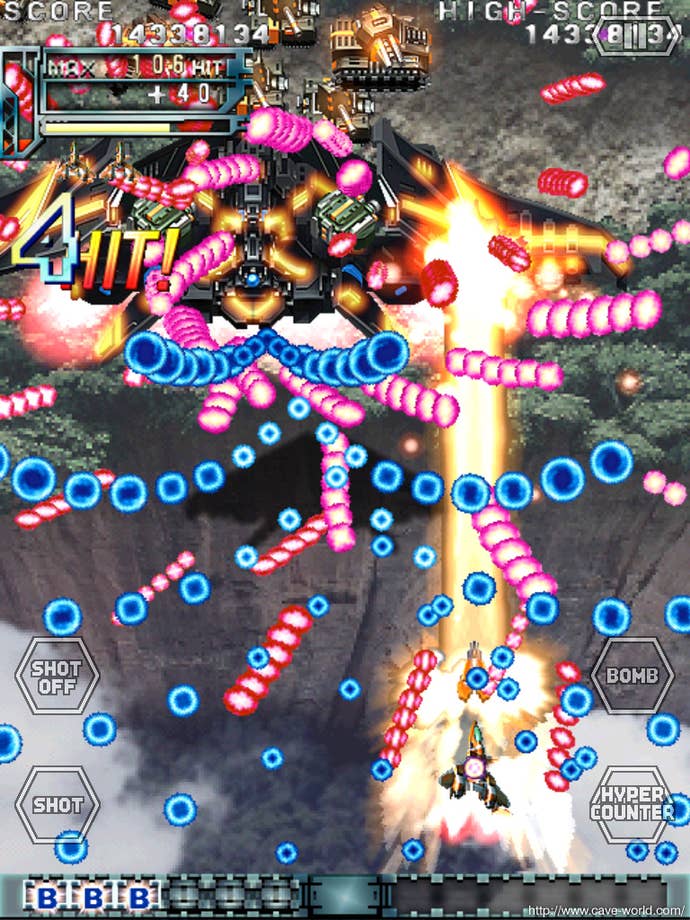
Cave's DoDonPachi Resurrection (also known as DoDonPachi Dai-Fukkatsu) came to arcades in 2008, then was ported to iOS in 2010, with an Xbox 360 version to follow shortly afterwards. An Android version followed in 2011, and an "HD" iPad version is also available.
Like Espgaluda II, the mobile version of DoDonPachi Resurrection incorporates both the original arcade mode's combo-based scoring and a smartphone-specific mode. In this instance, the smartphone mode incorporates a meter in the corner of the screen that shifts between S and M, which stand for Slaughter and Menace respectively. Grazing bullets without them touching your hitbox moves the gauge closer to Menace, which allows your score multiplier to increase, while destroying enemies moves it closer to Slaughter, which applies the current multiplier, increases the power of your weapons and produces score items when destroying enemies or cancelling bullets.
Attaining high scores in DoDonPachi Resurrection involves a keen knowledge of a number of aspects: what enemies are coming when, what the best time to use your bullet-cancelling "hyper" attack is, and how to maximize the number of score items that dead enemies shower you with. It's a challenging system to get to grips with, but while practicing you're rewarded with some of the flashiest 2D graphics you'll see in a mobile game coupled with an infectiously cheerful soundtrack.
The Xbox 360 version - which, for some reason, never saw a North American release but did make it to Europe courtesy of Rising Star Games - includes a selection of different game modes, some of which make the already-complex scoring system even more convoluted. The updated "Black Label" arcade mode is also available as DLC, complete with rockin' new soundtrack.
Why you should play it: Giant robot schoolgirls.
DoDonPachi Maximum

Originally released as a Windows Phone exclusive, DoDonPachi Maximum was later ported to iOS. It is the first game in the series to be specifically developed for mobile phones, and as such makes use of a somewhat simplified control scheme over some of Cave's previous offerings. It's one of the more accessible danmaku titles out there, but also arguably one of the least impressive to look at thanks to its peculiar, heavily-pixelated retro-style aesthetic.
Unlike most of the other DoDonPachi games, which have an overblown (and largely irrelevant) story to frame the action, DoDonPachi Maximum simply frames its experience as the player piloting a "Maximum Bullet Simulator" and training their reflexes. You'll find yourself flying through a series of rather abstract levels, blasting enemies that look as if they're being rendered on an old green-screen monitor.
DoDonPachi Maximum's scoring system makes use of a variation on the "combo" system used in previous installments of the series. Shooting enemies in succession increases the combo meter and subsequently the amount of points that can be earned for further hits or collecting score items. The closer you are to an enemy when you destroy it, the more valuable score items that come out. Bonuses are attained at the end of the level according to how many items were collected, and whether you managed to make it through without losing a life, without using a bomb or with one hundred per cent of the enemies shot down.
Unusually for the genre, DoDonPachi Maximum records scores for each level completely separately and allows you to start the game from any previously-unlocked level. Beating a level with at least two out of the three bonuses moves you onto a harder variant for the subsequent level; failing to attain at least two of the bonuses moves you onto an easier path. This provides a total of 15 different variations on the five different stages you'll play in a complete run-through of the game.
Why you should play it: The per-level scoring makes for an ideal "quick-hit" mobile game rather than requiring you to spend 20-30 minutes running through the whole sequence of levels.
Deathsmiles
[Deathsmiles'] last boss is called "Tyrannosatan" and shows up on screen accompanied by Bach's Toccata and Fugue in D Minor.
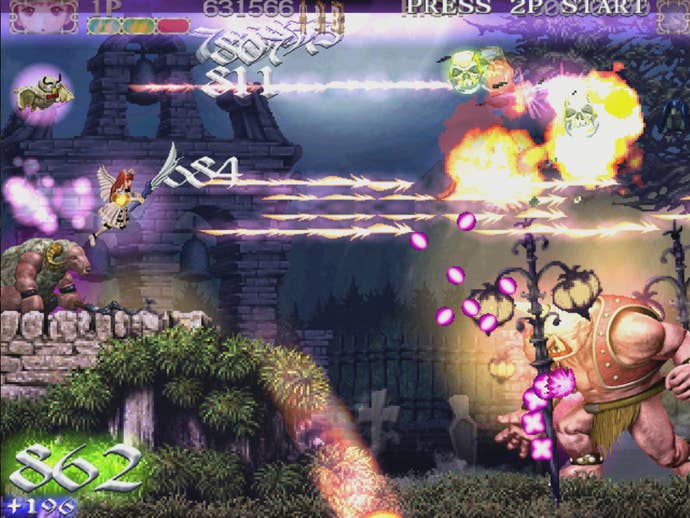
Unlike Espgaluda and the DoDonPachi series, Cave's Deathsmiles is a horizontal-perspective shmup rather than a vertical scroller. It's also one of Cave's more accessible titles in terms of difficulty, though its complicated scoring system means that you'll still have to take some time to master its quirks before you can even think about rising up the leaderboards. It originally launched in arcades in 2007, was ported to Xbox 360 for a 2009 release in Japan (2010 in the US, 2011 for Europe) and was subsequently also ported to iOS, though at the time of writing, it's a non-universal app designed specifically for the small screen of the iPhone.
Deathsmiles casts you in the role of one of several different underage flying Gothic lolitas, each of whom has their own style of attacking, and each of whom has their own "familiar" character that flies along with them and can help protect them from the incoming swarms of bullets. Each character has several different attacks -- a rapid-fire shot, a continuous laser beam, a "lock-on" shot and a bomb - and each enemy shatters into valuable score items when destroyed, with more items exploding from their corpse if the "correct" attack type is used to defeat them. Creating then collecting bajillions of these shiny pickups is one of the most satisfying experiences in all of gaming.
Deathsmiles' console and iOS editions have more pronounced differences than some of Cave's other releases: the 360 version incorporates numerous variations on the basic formula (including "Xbox 360" modes with remastered graphics) while the iOS version includes a completely new component in which players take on the role of an original character, gradually upgrading her abilities by purchasing equipment.
Oh, also, the last boss is called "Tyrannosatan," and shows up on screen accompanied by a stirring rendition of Bach's Toccata and Fugue in D Minor, which makes this game worth playing by itself.
Why you should play it: Did you not hear what the last boss is called?
Ikaruga

No discussion of danmaku games would be complete without mentioning Treasure's Ikaruga, which originally hit Japanese arcades in 2001, was ported to Dreamcast in 2002, finally made it to the West in its 2003 Gamecube incarnation and was eventually rereleased on Xbox Live Arcade in 2008. It would be followed by an XBLA rerelease of its spiritual predecessor Radiant Silvergun some two years later in 2011 -- oddly appropriate, given the latter's mind-bending non-linear plot and stage structure.
Ikaruga is credited with popularizing the "polarity shooter" mechanic, in which the player's ship is able to swap between two different colors, absorbing attacks of one color while dealing double damage to the other. Achieving high scores in Ikaruga comes from creating "chains" by destroying enemies of the same polarity in succession. Most of the game's challenge comes from figuring out what polarity your ship should be in at any given moment -- do you enjoy relative invincibility, or do you focus on dealing as much damage as possible?
Ikaruga was the work of just three people at Treasure, supported by contractors from Border Down developer G.rev. It took over two years to put the whole game together -- a long time by arcade standards -- but most Ikaruga fans agree that the long gestation period was well-spent assembling one of the finest shmups of all time.
Why you should play it: One of the finest danmaku shmups of all time, and a timeless classic, Ikaruga introduced many Westerners to the joys of this challenging genre.
Danmaku Unlimited
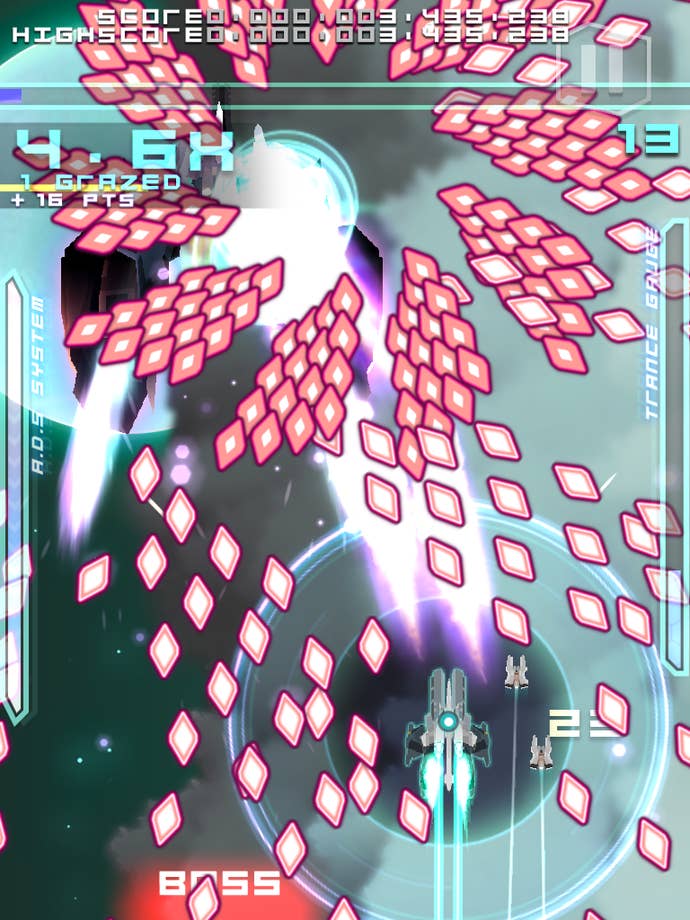
Lest this become nothing but a list of games by Cave -- which are, to be fair, among the best in the business -- it's probably time to mention some games by other developers, beginning with Doragon Entertainment's Danmaku Unlimited series for mobile platforms.
These highly-polished games feature impressive 3D graphics as opposed to the 2D sprite art favored by Cave; a stirring soundtrack, provided by independent Japanese band Blankfield in the case of the sequel; and some interesting play mechanics. While challenging, they're also some of the more accessible examples of the genre.
Danmaku Unlimited 2 features two different play modes with slightly different mechanics, and incorporates a helpful tutorial that explains not only how the controls work, but also how the scoring system works. Given Cave's notoriously byzantine scoring systems, this is something the Japanese shmup giant could perhaps learn from.
The developer of the Danmaku Unlimited series is one Sunny Tam, a Vancouver-based graduate of Canada's Simon Fraser University. This makes Danmaku Unlimited one of the relatively few examples of Western-developed danmaku titles - and it's clear from his work that he both loves and understands the thrill and appeal of a dive into bullet hell.
Why you should play it: As proof that someone other than Cave can make spectacular, high-quality bullet hell shmups.
Shogun: Rise of the Renegade

Another Western-developed danmaku title, Shogun is the work of French studio int13, whose other work on mobile primarily consists of augmented reality games. Shogun, meanwhile, is a loving homage to Japanese danmaku shmups that successfully manages to carve out its own distinctive identity thanks to its attractive 3D backdrops, pixelated retro-style 2D sprites, Amiga-style digital music and interesting game mechanics.
Shogun forces the player to think carefully about how they use their limited resources during a mission and how much they want to take risks. The player has a stock of energy capsules to use throughout the level, and may acquire more by either "grazing" enemy bullets or picking up dropped powerups from enemies. The twist is that these energy capsules are both the player's stock of lives and the resource required to upgrade their ship's three weapons. Upgrade a lot and you'll have a powerful weapon, but it'll only take a hit or two to destroy your shields and put you out of the game. Don't upgrade at all and you might survive a little longer, but you'll find it tough to defeat enough enemies to attain a high score.
Shogun also makes use of an interesting system to allow switching between weapons without requiring clumsy fixed on-screen buttons - releasing your finger from the screen puts the game in slow-motion and allows you to tap icons surrounding your ship to switch between the three different fire modes along with upgrading the currently-selected weapon or launching an EMP blast to destroy on-screen bullets.
In an interesting twist on the usual, largely story-free nature of most shmups, Shogun provides some degree of characterization and ongoing narrative to its experience through talking-head portraits and text boxes. While most shmups simply focus on chasing high scores and remain entirely satisfying in the process, it's sometimes nice to have a little extra context to the things you're blowing up.
Why you should play it: It looks, sounds and feels like an Amiga game... in a good way.
Gundemonium Collection
Hitogata Happa demands that you suicidally fling your avatar "dolls" at enemies in order to kill them in many situations.
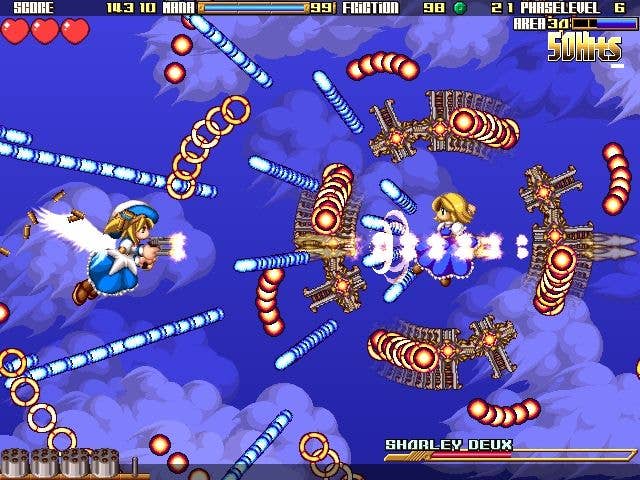
All right, this is technically three games, but since they can be acquired as a single pack for a very reasonable price on both PS3 and PC, it's worth considering them together.
The Gundemonium Collection, developed by Japanese independent developer Aeju Murasame (better known as Platine Dispositif), consists of the titles Gundemonium Recollection, Gundeadligne and Hitogata Happa. The first two of these are horizontally-scrolling shooters set in a peculiar occult-infused Steampunk take on what appears to be 18th century America, while the third is a vertically-scrolling shmup, and actually a prequel to the first two games' complicated and borderline-nonsensical story.
Each game in the series has noticeably different mechanics -- Gundemonium Recollection features a customizable player character, where you can combine several different shot, bomb and "mana action" special attacks to create a character that fits your play style; Gundeadligne features the ability to shoot in both directions -- much like Deathsmiles in this respect -- as well as two-player cooperative play (including online); while Hitogata Happa, curiously, practically demands that you suicidally fling your avatar "dolls" at enemies in order to kill them in many situations -- a mechanic supported by the much larger-than-average stock of lives the game provides you with.
The Steam versions of these games are arguably the definitive editions, as they feature uncensored artwork -- for some inexplicable reason, many of the enemies in the game forgot to put on any underpants, though nothing actually explicit is shown -- and some seriously excellent remixed soundtracks.
Why you should play it: A wide array of difficulty levels make these games as accessible or demanding as you please.
Jamestown
[Mars] is a British colony contested by both the Spaniards and the indigenous Martians.

If you've never played a danmaku title before, Final Form Games' PC offering Jamestown is the perfect place to start. Its superb gradation of difficulty gradually trains you in the fine art of avoiding bullets and mastering complicated scoring mechanics before throwing you into bullet hell proper -- and despite the seemingly small variety of levels on offer, there's plenty to do thanks to several different player ships, a variety of difficulty levels and a whole host of unlockable extras.
While Jamestown is a Western-developed offering, Final Form Games proves itself to be up there with the Japanese in terms of head-scratchingly bizarre plots. I'll just say that the game takes place on Mars, in the 17th Century, and that the planet in question is a British colony contested by both the Spaniards and the indigenous Martians, and leave you to discover the details for yourself. The game's story is relatively short, but you can then replay it at higher difficulties, in the amusing "Farce" mode, or tackle a variety of incredibly tough challenges. Then you can also play it with up to three friends -- local only, sadly -- or tackle the additional content found in the DLC packs.
Worth noting, though, is the fact that the game has issues with certain ATI graphics cards, so be sure to check compatibility before you hand over your money to avoid disappointment.
Why you should play it: For the 17th century-style "chapter headers" that mark the beginning of each level.
eXceed Collection
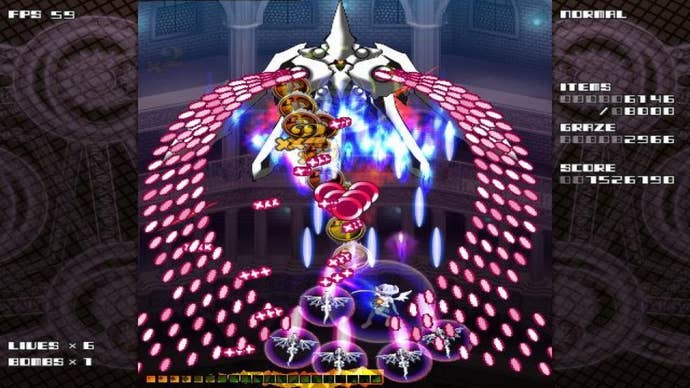
Yep, another trilogy, but again one that can be easily acquired on PC for a very reasonable price thanks to localization specialists Nyu Media.
The eXceed series is made up of three independently-developed Japanese games, each of which is a danmaku title, but each of which has their own twist on the formula. The first game, for example, features a mechanic whereby the player's special weapon is charged up by grazing bullets, while the second features an Ikaruga-style "polarity" system whereby it's possible to avoid damage from attacks with the same polarity while dealing double damage to enemies of the opposite color. The third game was put together by a completely different developer and consequently has almost nothing to do with the first two, but is arguably the most polished of the three.
The eXceed series' narrative follows the struggles between humanity, vampires and, in the case of the third game, dragons and demons. As is usually the case with shmups, the plot is somewhat convoluted and hard to follow - not helped by the fact that the first game in the series never received an official translation into English - but is ultimately largely irrelevant to enjoyment of the experience as a whole. These are some great shooters with some kick-ass soundtracks, though you'd better be ready for a particularly stiff challenge.
Why you should play it: As an example of a danmaku shmup that at least attempts - not altogether successfully - to fuse story and gameplay.
